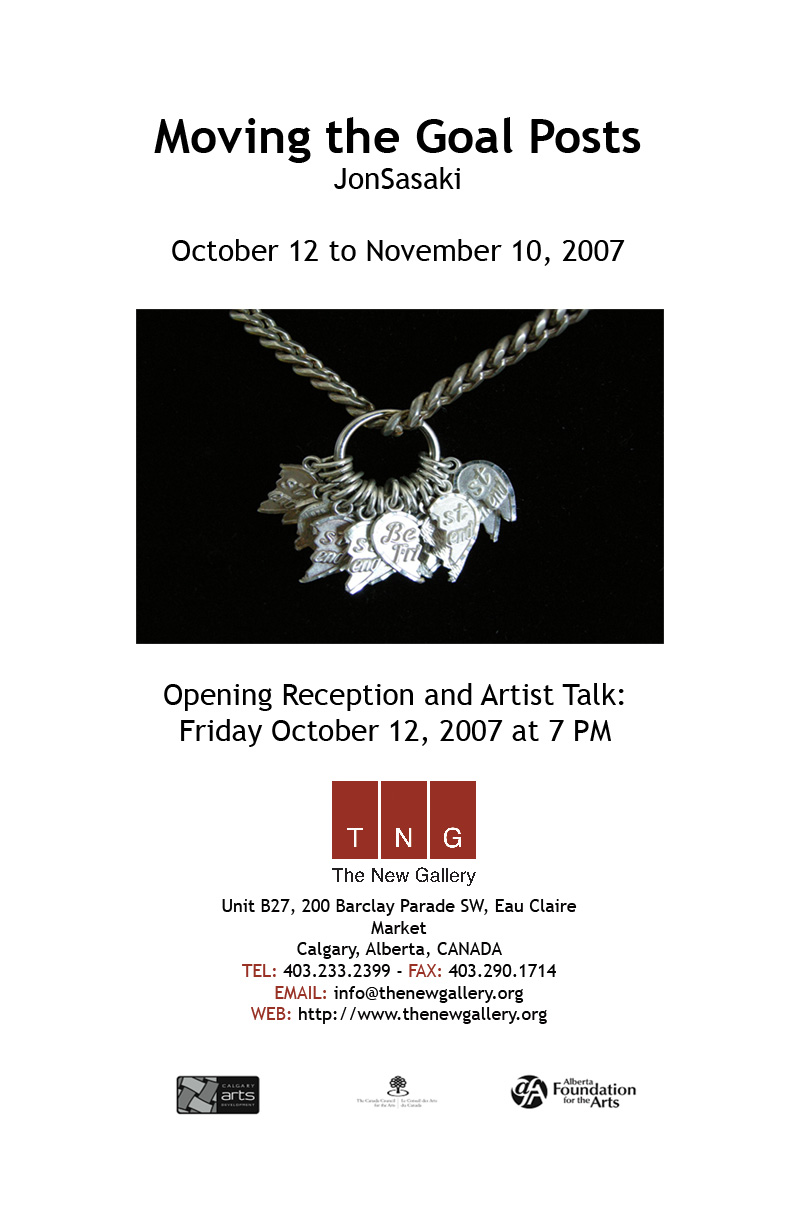
Moving the Goal Posts
Jon Sasaki
October 12 - November 10, 2007

Jon Sasaki’s looped two-minute video Fireworks (2006) refers to a sentimental and spectacular entertainment with lengthy historical roots that continues to evolve technologically and to serve as a marvelous distraction throughout the world. Sasaki’s work is neither sentimental nor spectacular: a neutrally dressed man is depicted in a room lighting two slender fireworks and placing them inside a translucent Plexiglass cube placed atop a white pedestal. The mere act of containing this vibrant- normally outdoor and public- display within both a cube and a building may be read as a subversive, possibly illegal, act with subtle regressive connotations of the teenage prankster mentality. This initially may seem visually mesmerizing and novel, as one is seduced by explosive, potentially hazardous, flashes of light and lovely plumes of smoke seeping out from under the cube. But the seduction is short-lived. As with much of Sasaki’s oeuvre to date, the gesture enacted by the artist is formally restrained, humble, and simple; repeated viewing results in an appreciation of the absurdity of the act and an enriched symbolic resonance for the work that far exceeds the semantic context of spectacle.
The abstraction and geometry of Fireworks recall minimalist efforts to explore relationships between the body and their art object, to render surfaces freed from obviously authorial signs of the artist’s hand - and the modernist mythology of artistic originality that these signs perpetuate. Using a minimalist vocabulary, pioneering conceptual artists further critiqued traditional aesthetics by straying from the formalist idea of viewing the artwork in an instant- by emphasizing the temporal nature of the sculptural object, as in Hans Haacke’s Condensation Cube (1963-65) in which a watery film was allowed to accumulate over
time on the inside of a cubic structure in response to the frequency and breathing of visitors in the gallery. Like Haacke, Sasaki obviously features a process far more dynamic than condensation and evaporation: a series of explosions. But this event is rendered from a position that is emotionally and bodily distanced- with video footage shot from the “objective” view of a stationary camera.
And yet the artist himself inserts his own likeness and subjectivity into works as the initiator and undisputed author of comic experiments. Some of these ventures are endurance tests, as in two elegantly executed videos from 2006, Ladder Climb and 24 lbs. Ladder Climb depicts Sasaki in an open, outdoor space attempting repeatedly to scale an unsupported ladder while simultaneously holding it up. Set in front of a building with a sign that says “Better Living,” the work may be read in terms of Sasaki’s own professional strivings, up a succession of rungs, and the presumed risks - maybe of an ethical “falling” from grace -as one ascends. But, as is often the case in the culture industry, the ascent may be only momentary and is followed by another, increasingly fatigued, attempt. The endless repetition of a basic gesture performed by the artist is suggestive of neurotic behavior that was the subject of 1970s video works by self-representing feminist video artists, such as Marina Abromovic, who videotaped herself aggressively brushing her hair in the art-world critique Art Must be Beautiful, Artist Must be Beautiful. The narcissistic, self-inflicted sufferings of Abramovic’s project are not apparent in Sasaki’s reserved, “everyman” on-screen persona: in the work 24 lbs. the artist is shown holding an anvil over the edge of his apartment’s balcony, a scenario that does have dramatic overtones stemming from a lack of knowledge about whether there are innocent bystanders about to be flattened on the street below. Perhaps the artist is holding the anvil because of a wager or because he lost one. But the level of danger and self-righteous sacrifice is subdued in Sasaki’s protagonistic and straight-faced struggle to reconcile the roles, competencies, and skills of the artist with those of the slapstick performer who finds himself --like the legendary “professionals” of physical comedy with exceptional athletic ability that Sasaki admires, such as Buster Keaton-- in a series of funny, but decidedly tragic, predicaments-- situations that are extremely unlikely but never stray completely from the realm of possibility.
- Dan Adler
![]()
![]()
![]()
The abstraction and geometry of Fireworks recall minimalist efforts to explore relationships between the body and their art object, to render surfaces freed from obviously authorial signs of the artist’s hand - and the modernist mythology of artistic originality that these signs perpetuate. Using a minimalist vocabulary, pioneering conceptual artists further critiqued traditional aesthetics by straying from the formalist idea of viewing the artwork in an instant- by emphasizing the temporal nature of the sculptural object, as in Hans Haacke’s Condensation Cube (1963-65) in which a watery film was allowed to accumulate over
time on the inside of a cubic structure in response to the frequency and breathing of visitors in the gallery. Like Haacke, Sasaki obviously features a process far more dynamic than condensation and evaporation: a series of explosions. But this event is rendered from a position that is emotionally and bodily distanced- with video footage shot from the “objective” view of a stationary camera.
And yet the artist himself inserts his own likeness and subjectivity into works as the initiator and undisputed author of comic experiments. Some of these ventures are endurance tests, as in two elegantly executed videos from 2006, Ladder Climb and 24 lbs. Ladder Climb depicts Sasaki in an open, outdoor space attempting repeatedly to scale an unsupported ladder while simultaneously holding it up. Set in front of a building with a sign that says “Better Living,” the work may be read in terms of Sasaki’s own professional strivings, up a succession of rungs, and the presumed risks - maybe of an ethical “falling” from grace -as one ascends. But, as is often the case in the culture industry, the ascent may be only momentary and is followed by another, increasingly fatigued, attempt. The endless repetition of a basic gesture performed by the artist is suggestive of neurotic behavior that was the subject of 1970s video works by self-representing feminist video artists, such as Marina Abromovic, who videotaped herself aggressively brushing her hair in the art-world critique Art Must be Beautiful, Artist Must be Beautiful. The narcissistic, self-inflicted sufferings of Abramovic’s project are not apparent in Sasaki’s reserved, “everyman” on-screen persona: in the work 24 lbs. the artist is shown holding an anvil over the edge of his apartment’s balcony, a scenario that does have dramatic overtones stemming from a lack of knowledge about whether there are innocent bystanders about to be flattened on the street below. Perhaps the artist is holding the anvil because of a wager or because he lost one. But the level of danger and self-righteous sacrifice is subdued in Sasaki’s protagonistic and straight-faced struggle to reconcile the roles, competencies, and skills of the artist with those of the slapstick performer who finds himself --like the legendary “professionals” of physical comedy with exceptional athletic ability that Sasaki admires, such as Buster Keaton-- in a series of funny, but decidedly tragic, predicaments-- situations that are extremely unlikely but never stray completely from the realm of possibility.
- Dan Adler



Bios
Based in Toronto, Dan Alder is assistant professor of modern and contemporary art history at the University of Guelph. He has published in the London-based journal Art History and regularly contributes to Artforum magazine. An alumnus of the Whitney Museum’s Independent Study Program, he holds a doctorate in art history from the Graduate Center, City University of New York.
Currently living in Toronto, Jon Sasaki has shown his videos in cities across the globe including New York, Shanghai, and Naples. He is also an active member of Instant Coffee, a North American art collective; with Instant Coffee, Sasaki has also had the opportunity to have his work viewed internationally. The artist completed his BFA at Mount Allison University in 1996.
Based in Toronto, Dan Alder is assistant professor of modern and contemporary art history at the University of Guelph. He has published in the London-based journal Art History and regularly contributes to Artforum magazine. An alumnus of the Whitney Museum’s Independent Study Program, he holds a doctorate in art history from the Graduate Center, City University of New York.
Currently living in Toronto, Jon Sasaki has shown his videos in cities across the globe including New York, Shanghai, and Naples. He is also an active member of Instant Coffee, a North American art collective; with Instant Coffee, Sasaki has also had the opportunity to have his work viewed internationally. The artist completed his BFA at Mount Allison University in 1996.
